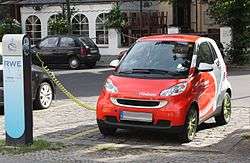Battery electric vehicle
A battery electric vehicle (BEV), pure electric vehicle, only-electric vehicle or all-electric vehicle is a type of electric vehicle (EV) that exclusively uses chemical energy stored in rechargeable battery packs, with no secondary source of propulsion (e.g. hydrogen fuel cell, internal combustion engine, etc.). BEVs use electric motors and motor controllers instead of internal combustion engines (ICEs) for propulsion. They derive all power from battery packs and thus have no internal combustion engine, fuel cell, or fuel tank. BEVs include – but are not limited to[1][2] – motorcycles, bicycles, scooters, skateboards, railcars, watercraft, forklifts, buses, trucks, and cars.
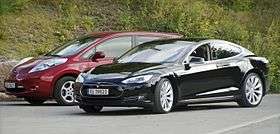
In 2016 there were 210 million electric bikes worldwide used daily.[3] Cumulative global sales of highway-capable light-duty pure electric car vehicles passed the one million unit milestone in September 2016.[4] As of the end of 2019, the world's top selling highway legal all-electric car in history is the Nissan Leaf with global sales of 450,000 units, followed very closely by the Tesla Model 3 with 448,634 sales.[5]
History
In 1884 Thomas Parker built a practical production electric car in Wolverhampton using his own specially designed high-capacity rechargeable batteries. First introduced in 1889, battery vehicles milk floats expanded in 1931 and by 1967 gave Britain the largest electric vehicle fleet in the world.
Terminology
Hybrid electric vehicle use both electric motors and internal combustion engines, and are not considered pure or all-electric vehicles.[6]
Hybrid electric vehicle whose batteries that can be charged externally are called plug-in hybrid electric vehicles (PHEV), and run as BEVs during their charge-depleting mode. PHEVs with a series powertrain are also called range-extended electric vehicles (REEVs), such as the Chevrolet Volt and Fisker Karma.
Plug-in electric vehicles (PEVs) are a subcategory of electric vehicles that includes battery electric vehicles (BEVs) and Plug-in hybrid vehicles, (PHEVs),
The electric vehicle conversions of hybrid electric vehicles and conventional internal combustion engine vehicles (aka all-combustion vehicles) belong to one of the two categories.[6][7]
In China, plug-in electric vehicles, together with hybrid electric vehicles are called new energy vehicles (NEVs).[8] However, in the United States, neighborhood electric vehicles (NEVs) are battery electric vehicles that are legally limited to roads with posted speed limits no higher than 45 miles per hour (72 km/h), are usually built to have a top speed of 30 miles per hour (48 km/h), and have a maximum loaded weight of 3,000 pounds (1,400 kg).[9]
Vehicles by type
The concept of battery electric vehicles is to use charged batteries on board vehicles for propulsion. Battery electric cars are becoming more and more attractive with the higher oil prices and the advancement of new battery technology (Lithium Ion) that have higher power and energy density (i.e., greater possible acceleration and more range with fewer batteries).[10] compared to older battery types such as lead-acid batteries. Lithium-ion batteries for example now have an energy density of 0.9–2.63 MJ/L whereas lead-acid batteries had an energy density of 0.36 MJ/L (so 2.5 to 7.3x higher). There is still a long way to go if comparing it to petroleum-based fuels and biofuels however (gasoline having an energy density of 34.2 MJ/L -38x to 12.92x higher- and ethanol having an energy of 24 MJ/L -26x to 9.12x higher-).
BEVs include automobiles, light trucks, and neighborhood electric vehicles.
Rail
- Battery electric railcars:
Battery electric trains in the form of BEMUs (battery electric multiple units) are operated commercially in Japan. They are charged via pantographs, either when driving on electrified railway lines or during stops at specially equipped train stations. They use battery power for propulsion when driving on railway lines that are not electrified, and have successfully replaced diesel multiple units on some such lines.
Other countries have also tested or ordered such vehicles.
- Locomotives:
- Electric rail trolley:
Electric bus
Chattanooga, Tennessee operates nine zero-fare electric buses, which have been in operation since 1992 and have carried 11.3 million passengers and covered a distance of 3,100,000 kilometres (1,900,000 mi), they were made locally by Advanced Vehicle Systems. Two of these buses were used for the 1996 Summer Olympics in Atlanta.[11][12]
Beginning in the summer of 2000, Hong Kong Airport began operating a 16-passenger Mitsubishi Rosa electric shuttle bus, and in the fall of 2000, New York City began testing a 66-passenger battery-powered school bus, an all-electric version of the Blue Bird TC/2000.[13] A similar bus was operated in Napa Valley, California for 14 months ending in April 2004.[14]
The 2008 Beijing Olympics used a fleet of 50 electric buses, which have a range of 130 km (81 mi) with the air conditioning on. They use Lithium-ion batteries, and consume about 1 kW⋅h/mi (0.62 kW⋅h/km; 2.2 MJ/km). The buses were designed by the Beijing Institute of Technology and built by the Jinghua Coach.[15] The batteries are replaced with fully charged ones at the recharging station to allow 24-hour operation of the buses.[16]
In France, the electric bus phenomenon is in development, but some buses are already operating in numerous cities.[17] PVI, a medium-sized company located in the Paris region, is one of the leaders of the market with its brand Gepebus (offering Oreos 2X and Oreos 4X).[18]
In the United States, the first battery-electric, fast-charge bus has been in operation in Pomona, California since September 2010 at Foothill Transit. The Proterra EcoRide BE35 uses lithium-titanate batteries and is able to fast-charge in less than 10 minutes.[19]
In 2012, heavy-duty trucks and buses contributed 7% of global warming emissions in California.[20]
In 2014, the first production model all-electric school bus was delivered to the Kings Canyon Unified School District in California's San Joaquin Valley. The bus was one of four the district ordered. This battery electric school bus, which has 4 sodium nickel batteries, is the first modern electric school bus approved for student transportation by any state.[21]
In 2016, including the light heavy-duty vehicles, there were roughly 1.5 million heavy-duty vehicles in California.[20]

The same technology is used to power the Mountain View Community Shuttles. This technology was supported by the California Energy Commission, and the shuttle program is being supported by Google.[22]
Thunder Sky
Thunder Sky (based in Hong Kong) builds lithium-ion batteries used in submarines and has three models of electric buses, the 10/21 passenger EV-6700 with a range of 280 km (170 mi) under 20 mins quick-charge, the EV-2009 city buses, and the 43 passenger EV-2008 highway bus, which has a range of 300 km (190 mi) under quick-charge (20 mins to 80 percent), and 350 km (220 mi) under full charge (25 mins). The buses will also be built in the United States and Finland.[23]
Free Tindo
Tindo is an all-electric bus from Adelaide, Australia. The Tindo (aboriginal word for sun) is made by Designline International[24] in New Zealand and gets its electricity from a solar PV system on Adelaide's central bus station. Rides are zero-fare as part of Adelaide's public transport system.[25]
First Fast-Charge, Battery-Electric Transit Bus
Proterra's EcoRide BE35 transit bus, called the Ecoliner by Foothill Transit in West Covina, California, is a heavy duty, fast charge, battery-electric bus. Proterra's ProDrive drive-system uses a UQM motor and regenerative braking that captures 90 percent of the available energy and returns it to the TerraVolt energy storage system, which in turn increases the total distance the bus can drive by 31–35 percent. It can travel 30–40 miles (48–64 km) on a single charge, is up to 600 percent more fuel-efficient than a typical diesel or CNG bus, and produces 44 percent less carbon than CNG.[26]
Electric trucks
For most of the 20th century, the majority of the world's battery electric road vehicles were British milk floats.[27] The 21st century saw the massive development of BYD electric trucks.[28]
Electric vans
In March 2012, Smith Electric Vehicles announced the release of the Newton Step-Van, an all-electric, zero-emission vehicle built on the versatile Newton platform that features a walk-in body produced by Indiana-based Utilimaster.[29]
BYD supplies DHL with electric distribution fleet of commercial BYD T3.[30]
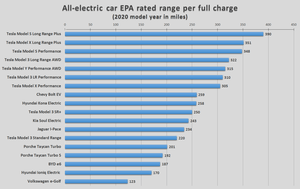
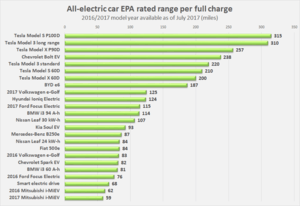
Electric cars
A battery-powered electric car is an automobile which is propelled by electric motors.
Although electric cars often give good acceleration and have generally acceptable top speed, the lower specific energy of production batteries available in 2015 compared with carbon-based fuels means that electric cars need batteries that are fairly large fraction of the vehicle mass but still often give relatively low range between charges. Recharging can also take significant lengths of time. For journeys within a single battery charge, rather than long journeys, electric cars are practical forms of transportation and can be recharged overnight.
Electric cars can significantly reduce city pollution by having zero tail pipe emissions.[33][34][35] Vehicle greenhouse gas savings depend on how the electricity is generated.[36][37] With the current US energy mix, using an electric car would result in a 30 percent reduction in carbon dioxide emissions.[38][39][40][41] Given the current energy mixes in other countries (that are transiting to more renewables), it has been predicted that such emissions would decrease by 40 percent in the UK,[42] 19 percent in China,[43] and as little as 1 percent in Germany.[44][45]
Electric cars are having a major impact in the auto industry[46][47] given advantages in city pollution, less dependence on oil and combustion, and scarcity and expected rise in gasoline prices.[48][49][50] World governments are pledging billions to fund development of electric vehicles and their components. The US has pledged US$2.4 billion in federal grants for electric cars and batteries.[51] China has announced it will provide US$15 billion to initiate an electric car industry.[52]
In 2015, it was the first time BYD also ranked first in accumulated global sales throughout an entire year – with a total of over 43,073 NEVs sold (a >220% surge compared to last year), exceeding all American, Japanese and European leaders to date.[53]
Cumulative global sales of highway-capable battery electric cars and vans passed the 1 million unit milestone in September 2016.[4] The Renault-Nissan Alliance is the leading all-electric vehicle manufacturer. The Alliance achieved the sales milestone of 350,000 all-electric vehicles delivered globally in August 2016.[54] Ranking second is Tesla Motors with over 139,000 electric cars sold between 2008 and June 2016.[55][56]

As of December 2016, the world's top selling highway capable all-electric car in history is the Nissan Leaf, released in December 2010, with global sales of more than 250,000 units, followed by the Tesla Model S with more than 158,000 units delivered worldwide.[58] Ranking next are the BMW i with about 65,500 units, and the Renault Zoe with 61,205 units, both through December 2016.[59] Until June 2016 the Mitsubishi i-MiEV family ranked fifth with about 37,600 units delivered globally.[60] The Renault Kangoo Z.E. utility van is the leader of the light-duty all-electric segment with global sales of 25,205 units through December 2016.[61]
Formula E is a fully electric international single seater championship. The series was conceived in 2012, and the inaugural championship started in Beijing on 13 September 2014. The series is sanctioned by the FIA. Alejandro Agag is the current CEO of Formula E.
The Formula E championship is currently contested by ten teams with two drivers each (after the withdrawal of Team Trulli, there are temporarily only nine teams competing). Racing generally takes place on temporary city-center street circuits which are approximately 2 to 3.4 kilometres (1.2 to 2.1 mi) long. Currently, only the Mexico City ePrix takes place on a road course, a modified version of the Autódromo Hermanos Rodríguez.
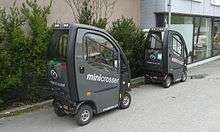
Special-purpose vehicles
Special-purpose vehicles come in a wide range of types, ranging from relatively common ones such as golf carts, things like electric golf trolleys, milk floats, all-terrain vehicles, neighborhood electric vehicles, and a wide range of other devices. Certain manufacturers specialize in electric-powered "in plant" work machines.
.jpg)
Electric motorcycles, scooters and rickshaws
Three-wheeled vehicles include electric rickshaws, a powered variant of the cycle rickshaw. The large-scale adoption of electric two-wheelers can reduce traffic noise and road congestion but may necessitate adaptations of the existing urban infrastructure and safety regulations.[62]
Ather Energy from India has launched their BLDC motor powered Ather 450 electric scooter with Lithium Ion batteries in 2018.[63][64] Also from India, AVERA [65] - a new and renewable energy company is going to launch two models of electric scooters[66] at the end of 2018, with Lithium Iron Phosphate Battery technology.[67]
Electric bicycles

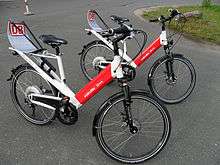
China has experienced an explosive growth of sales of non-assisted e-bikes including scooter type, with annual sales jumping from 56,000 units in 1998 to over 21 million in 2008,[68] and reaching an estimated 120 million e-bikes on the road in early 2010. China is the world's leading manufacturer of e-bikes, with 22.2 million units produced in 2009. Some of the largest e-bike manufacturers of e-bikes in the world are BYD, Geoby.
Personal transporters
An increasing variety of personal transporters are being manufactured, including the one-wheeled self-balancing unicycles, self-balancing scooters, electric kick scooters, and electric skateboards.
Technology
| Vehicle type | Fuel used |
|---|---|
| All-petroleum vehicle | Most use of petroleum |
| Regular hybrid electric vehicle | Less use of petroleum, but unable to be plugged in |
| Plug-in hybrid vehicle | Less use of petroleum, residual use of electricity |
| All-electric vehicle (BEV, AEV) | Most use of electricity |
Motor controllers
The motor controller receives a signal from potentiometers linked to the accelerator pedal, and it uses this signal to determine how much electric power is needed.[70] This DC power is supplied by the battery pack, and the controller regulates the power to the motor, supplying either variable pulse width DC or variable frequency variable amplitude AC, depending on the motor type. The controller also handles regenerative braking, whereby electrical power is gathered as the vehicle slows down and this power recharges the battery.[70] In addition to power and motor management, the controller performs various safety checks such as anomaly detection, functional safety tests and failure diagnostics.[71]
Battery pack
Most electric vehicles today use an electric battery, consisting of electrochemical cells with external connections in order to provide power to the vehicle.[72]
Battery technology for EVs has developed from early lead-acid batteries used in the late 19th century to the 2010s, to lithium-ion batteries which are found in most EVs today.[71] The overall battery is referred to as a battery pack, which is a group of multiple battery modules and cells. For example, the Tesla Model S battery pack has up to 7,104 cells, split in 16 modules with 6 groups of 74 cells in each. Each cell has a nominal voltage of 3-4 volts, depending on its chemical composition.
Motors
Electric cars have traditionally used series wound DC motors, a form of brushed DC electric motor. Separately excited and permanent magnet are just two of the types of DC motors available. More recent electric vehicles have made use of a variety of AC motor types, as these are simpler to build and have no brushes that can wear out. These are usually induction motors or brushless AC electric motors which use permanent magnets. There are several variations of the permanent magnet motor which offer simpler drive schemes and/or lower cost including the brushless DC electric motor.
Once electric power is supplied to the motor (from the controller), the magnetic field interaction inside the motor will turn the drive shaft and ultimately the vehicle's wheels.[70]
Economy
EV battery storage is a key-element for the global energy transition which is dependent on more electricity storage right now. As the energy availability is the most important factor for the vitality of an economy the mobile storage infrastructure of EV batteries can be seen as one of the most meaningful infrastructure projects facilitating the energy transition to a fully sustainably economy based on renewables. A meta study graphically showing the importance of electricity storage depicts the technology in context.[73]
Environmental impact
Power generation
Electric vehicles produce no greenhouse gas (GHG) emissions in operation, but the electricity used to power them may do so in its generation.[74] The two factors driving the emissions of battery electric vehicles are the carbon intensity of the electricity used to recharge the Electric Vehicle (commonly expressed in grams of CO2 per kWh) and the consumption of the specific vehicle (in kilometers/kWh).
The carbon intensity of electricity varies depending on the source of electricity where it is consumed. A country with a high share of renewable energy in its electricity mix will have a low C.I. In the European Union, in 2013, the carbon intensity had a strong geographic variability but in most of the member states, electric vehicles were "greener" than conventional ones. On average, electric cars saved 50%–60% of CO2 emissions compared to diesel and gasoline fuelled engines.
Moreover, the de-carbonisation process is constantly reducing the GHG emissions due to the use of electric vehicles. In the European Union, on average, between 2009 and 2013 there was a reduction in the electricity carbon intensity of 17%.[75] In a life-cycle assessment perspective, considering the GHG necessary to build the battery and its end-of-life, the GHG savings are 10-13% lower.[76]
Vehicle construction
GHGs are also emitted when the electric vehicle is being manufactured. The lithium-ion batteries used in the vehicle take more materials and energy to produce because of the extraction process of the lithium and cobalt essential to the battery.[77] This means the bigger the electric vehicle, the more carbon dioxide emitted.
The mines that are used to produce the lithium and cobalt used in the battery are also creating problems for the environment, as fish are dying up to 150 miles (240 km) downstream from mining operations due to chemical leaks and the chemicals also leak into the water sources the people that live near the mines use, creating health problems for the animals and people that live nearby.[78]
See also
| Wikimedia Commons has media related to Battery-powered vehicles. |
- All-electric range
- Automotive battery
- Battery balancing
- Electric boat
- Electric Drive Transportation Association (EDTA)
- Electric vehicle battery
- Electric vehicle warning sounds
- Global Electric Motorcars
- Government incentives for plug-in electric vehicles
- Greenpower
- Hydrogen vehicle
- List of electric cars currently available
- List of electric-vehicle-battery manufacturers
- List of production battery electric vehicles
- Miles per gallon gasoline equivalent
- Patent encumbrance of large automotive NiMH batteries
- Phase-out of fossil fuel vehicles
- Road-powered electric vehicle
- Short-commute vehicles
- Supercapacitor
- Think Global
- Tokyo Electric Power Company
- Wireless charging
References
- "FAQ". The Boring Company. Retrieved 8 April 2018.
- "literally hundreds of electric thrusters now operating in orbit on communications satellites, and ion and Hall thrusters both having been successfully used..." -https://descanso.jpl.nasa.gov/SciTechBook/series1/Goebel__cmprsd_opt.pdf
- "The State of the Electric Bicycle Market | Electric Bike Report | Electric Bike, Ebikes, Electric Bicycles, e Bike, Reviews".
- Shahan, Zachary (22 November 2016). "1 Million Pure EVs Worldwide: EV Revolution Begins!". cleantechnica.com. Retrieved 23 November 2016.
- PLUS, Nissan LEAF Nissan LEAF. "Nissan LEAF Sales Hit 450,000: World's #1 Selling EV, But Not For Long". InsideEVs. Retrieved 28 March 2020.
- David B. Sandalow, ed. (2009). Plug-In Electric Vehicles: What Role for Washington? (1st. ed.). The Brookings Institution. pp. 2–5. ISBN 978-0-8157-0305-1.See definition on pp. 2.
- "Plug-in Electric Vehicles (PEVs)". Center for Sustainable Energy, California. Archived from the original on 20 June 2010. Retrieved 31 March 2010.
- PRTM Management Consultants (April 2011). "The China New Energy Vehicles Program – Challenges and Opportunities" (PDF). World Bank. Retrieved 29 February 2012. See Acronyms and Key Terms, pp. v
- "What is a neighborhood electric vehicle (NEV)?". AutoblogGreen. 6 February 2009. Retrieved 9 June 2010.
- "-". Archived from the original on 5 February 2011. Retrieved 30 May 2015.
- Downtown Electric Shuttle Archived 13 September 2008 at the Wayback Machine. Retrieved 18 August 2008.
- Success Stories Archived 20 May 2008 at the Wayback Machine
- "Solectria Develops an All Electric Version of the Blue Bird TC2000". Archived from the original on 4 December 2008.
- Electric School Bus. Retrieved 18 August 2008.
- UNDP donates electric buses to Beijing Olympic Games. Retrieved 15 August 2008.
- "BIT Attends the Delivery Ceremony of the 2008 Olympic Games Alternative Fuel Vehicles with its Pure Electric Bus". Archived from the original on 6 December 2008.
- "Bus et navettes électriques – Actualités en France et dans le monde". avem.fr.
- "PVI, leader de la traction électrique pour véhicules industriels". Retrieved 30 May 2015.
- "Proterra Launches First Deployment of All-Electric, Zero-Emission Buses by Major Transit Agency". Archived from the original on 30 August 2011.
- Chandler, Sara; Espino, Joel; O’Dea, Jimmy (2016). "Delivering Opportunity: How Electric Buses and Trucks Can Create Jobs and Improve Public Health in California". Union of Concerned Scientists. JSTOR resrep17234. Cite journal requires
|journal=(help) - "New All-Electric School Bus Saves California District $10,000+ Per Year". CleanTechnica. 5 March 2014. Retrieved 1 March 2016.
- "Electric shuttle buses come to Mountain View, thanks to Motiv and Google". Silicon Valley Business Journal. 13 January 2015. Retrieved 30 May 2015.
- "雷天温斯顿电池有限公司". Archived from the original on 8 May 2015. Retrieved 30 May 2015.
- Posner, Andrew (19 December 2007). "When The Sun Shines Down Under. . .It Powers a Bus". TreeHugger. Retrieved 11 March 2012.
- "All-Electric, Solar-Powered, Free Bus!!!". Archived from the original on 8 September 2009.
- "Archived copy". Archived from the original on 30 August 2011. Retrieved 24 October 2011.CS1 maint: archived copy as title (link)
- "Escaping Lock-in: the Case of the Electric Vehicle". Cgl.uwaterloo.ca. Retrieved 27 November 2010.
- "byd-to-build-electric-trucks-in-ontario". Autotrader.ca. Retrieved 15 November 2017.
- smithelectric.com (5 March 2012). "Smith Electric Vehicle Launches Production of All-Electric Newton Step Van". smithelectric.com. Retrieved 5 March 2012.
- bydeurope.com (15 January 2016). "BYD supplies DHL with electric distribution fleet". bydeurope.com. Archived from the original on 19 July 2018. Retrieved 15 January 2016.
- Energy Efficiency & Renewable Energy, U.S. Department of Energy and U. S. Environmental Protection Agency (24 March 2017). "Find a car – Years: 2016–2017 – Vehicle Type: Electric". fueleconomy.gov. Retrieved 26 March 2017.
- Krok, Andrew (29 July 2017). "By the numbers: Tesla Model 3 vs. Chevrolet Bolt EV". CNET. Retrieved 29 July 2017.
- "Should Pollution Factor into Electric Car Rollout Plans?". Earth2tech.com. 17 March 2010. Archived from the original on 24 March 2010. Retrieved 18 April 2010.
- "Electro Automotive: FAQ on Electric Car Efficiency & Pollution". Electroauto.com. Retrieved 18 April 2010.
- "Clean Air Initiative". Archived from the original on 14 September 2016. Retrieved 30 May 2015.
- Notter, Dominic A.; Kouravelou, Katerina; Karachalios, Theodoros; Daletou, Maria K.; Haberland, Nara Tudela (2015). "Life cycle assessment of PEM FC applications: electric mobility and μ-CHP". Energy Environ. Sci. 8 (7): 1969–1985. doi:10.1039/c5ee01082a.
- Notter, Dominic A.; Gauch, Marcel; Widmer, Rolf; Wäger, Patrick; Stamp, Anna; Zah, Rainer; Althaus, Hans-Jörg (1 September 2010). "Contribution of Li-Ion Batteries to the Environmental Impact of Electric Vehicles". Environmental Science & Technology. 44 (17): 6550–6556. doi:10.1021/es903729a. ISSN 0013-936X. PMID 20695466.
- "Plug-in Hybrid Cars: Chart of CO2 Emissions Ranked by Power Source". TreeHugger. Archived from the original on 25 March 2010. Retrieved 18 April 2010.
- "Updated State-level Greenhouse Gas Emission Coefficients for Electricity Generation 1998–2000" (PDF). Archived from the original (PDF) on 28 July 2010. Retrieved 16 July 2010.
- "Electric Power Monthly – Table 1.1. Net Generation by Energy Source". Eia.doe.gov. Archived from the original on 15 April 2010. Retrieved 18 April 2010.
- United States emission standards#Electricity generation
- "Less CO2". My Electric Car. Archived from the original on 8 May 2010. Retrieved 18 April 2010.
- "McKinsey Greater China" (PDF). Archived from the original (PDF) on 16 December 2011. Retrieved 30 May 2015.
- ...the four electric vehicles analysed in this study consume around 1.7 times less primary energy and generate less than half the CO2 of a Toyota Prius... "Archived copy" (PDF). Archived from the original (PDF) on 26 July 2011. Retrieved 1 November 2010.CS1 maint: archived copy as title (link)
- Palm, Erik (1 May 2009). "Study: Electric cars not as green as you think | Green Tech – CNET News". News.cnet.com. Retrieved 18 April 2010.
- "Ford says auto future hinges on electric car | freep.com | Detroit Free Press". freep.com. Archived from the original on 21 April 2010. Retrieved 18 April 2010.
- Martin LaMonica (2 February 2009). "Plotting the long road to one million electric cars". CNN.com. Retrieved 18 April 2010.
- Terry Macalister (11 April 2010). "US military warns oil output may dip causing massive shortages by 2015 | Business". The Guardian. London. Archived from the original on 15 April 2010. Retrieved 18 April 2010.
- Macalister, Terry (7 February 2010). "Branson warns of oil crunch within five years | Business". The Guardian. London. Archived from the original on 16 April 2010. Retrieved 18 April 2010.
- Loveday, Eric (8 June 2010). "ALG predicts gas at $4.13 by 2013; residual values for compacts, hybrids to climb – Autoblog Green". Green.autoblog.com. Archived from the original on 14 August 2010. Retrieved 16 July 2010.
- "Obama pushes electric cars, battery power this week". USA Today. 14 July 2010.
- "Freidman OpEd: China's 'Moon Shot' Versus America's". Archived from the original on 3 November 2010.
- Business Wire (23 December 2015). "The World's Largest Electric Vehicle Maker Also Has a US Presence". BUSINESS WIRE.
- "Renault-Nissan Alliance hits milestone of 350,000 electric vehicles sold, maintains position as global EV leader" (Press release). Paris/Yokohama: Renault-Nissan Alliance. 13 September 2016. Archived from the original on 23 February 2017. Retrieved 13 September 2016. The Alliance has sold its 350,000th electric vehicle since December 2010, when the Nissan LEAF went on sale. The milestone was achieved in August 2016.
- Young, Angelo (4 April 2016). "Tesla Motors (TSLA) 1Q 2016 Sales: 14,820 Model S, Model X Cars Were Delivered In First Three Months; Model S Sales Jumped 45%". International Business Times. Retrieved 4 April 2016. Since 2008 almost 125,000 all-electric cars had been sold by Tesla Motors at the end of March 2016.
- "Tesla Second Quarter 2016 Update" (PDF) (Press release). Palo Alto: Tesla Motors. 3 August 2016. Retrieved 3 August 2016. During the second quarter of 2016 Tesla Motors delivered 14,402 new vehicles consisting of 9,764 Model S and 4,638 Model X. Production during 2Q 2016 totaled 18,345 vehicles.
- "Tesla Quietly Sold 200,000th Model S Last Year - HybridCars.com". HybridCars.com. 22 January 2018. Retrieved 24 April 2018.
- Cobb, Jeff (9 January 2017). "Nissan's Quarter-Millionth Leaf Means It's The Best-Selling Plug-in Car in History". HybridCars.com. Retrieved 10 January 2017. As of December 2016, the Nissan Leaf is the world's best-selling plug-in car in history with more than 250,000 units delivered, followed by the Tesla Model S with over 158,000 sales, the Volt/Ampera family of vehicles with 134,500 vehicles sold, and the Mitsubishi Outlander PHEV with about 116,500 units sold through November 2016. These are the only plug-in electric cars so far with over 100,000 global sales.
- Cobb, Jeff (31 January 2017). "Tesla Model S Is World's Best-Selling Plug-in Car For Second Year in a Row". HybridCars.com. Retrieved 31 January 2017. See also detailed 2016 sales and cumulative global sales in the two graphs.
- Cobb, Jeff (10 August 2016). "Global 10 Best-Selling Plug-In Cars Are Accelerating Forward". HybridCars.com. Retrieved 13 August 2016. As of June 2016, cumulative global sales of the top selling plug-in electric cars were led by the Nissan Leaf (over 228,000), followed by the Tesla Model S (129,393), Votl/Ampera family (about 117,300), Mitsubishi Outlander PHEV (about 107,400), Toyota Prius PHV (over 75,400), BYD Qin (56,191), Renault Zoe (51,193), BMW i3 (around 49,500 including REx variants), Mitsubishi i-MiEV family (about 37,600) and BYD Tang (37,509).
- Groupe Renault (January 2017). "Ventes Mensuelles" [Monthly Sales] (in French). Renault.com. Retrieved 18 January 2017. Includes passenger and light utility variants. Click on "(décembre 2016)" to download the file "XLSX – 239 Ko" for CYTD sales in 2016, and open the tab "Sales by Model". Click on "+ Voir plus" (See more) to download the files "Ventes mensuelles du groupe (décembre 2011) (xls, 183 Ko)" "Ventes mensuelles (décembre 2012) (xls, 289 Ko)" – Ventes mensuelles (décembre 2013) (xlsx, 227 Ko)" – "XLSX – 220 Ko Ventes mensuelles (décembre 2014)" – "Ventes mensuelles (décembre 2015)" to download the file "XLSX – 227 Ko" for 2011, 2012, 2013, 2014 and 2015 sales. Sales figures for 2013 were revised in the 2014 report
- Weiss M; Dekker P; Moro A; Scholz H; Martin P (2015). "On the electrification of road transportation – A review of the environmental, economic, and social performance of electric two-wheelers". Transportation Research Part D: Transport and Environment. 41, December 2015, Pages 348–366: 348–366. doi:10.1016/j.trd.2015.09.007.
- Ghoshal, Maria Thomas, Devjyot. "The launch of this e-scooter is a moment of reckoning for India's EV market". Quartz India. Retrieved 28 January 2020.
- "Ather Energy showcases S340, 'India's first smart scooter' at Surge 2016- Technology News, Firstpost". Tech2. 25 February 2016. Retrieved 28 January 2020.
- "AVERA Electric Vehicles". AVERA. Retrieved 19 September 2018.
- Varma, P. Sujatha (13 April 2018). "AVERA News on The Hindu". The Hindu. Retrieved 14 April 2018.
- Varma, P. Sujatha (7 October 2017). "City-based firm to launch e-bikes in New Year". The Hindu. Retrieved 8 October 2017.
- Chi-Jen Yang (2010). "Launching strategy for electric vehicles: Lessons from China and Taiwan" (PDF). Technological Forecasting and Social Change (77): 831–834. Archived from the original (PDF) on 31 March 2010.
- "Batterifergen har måttet stå over avganger. Nå er løsningen klar". Teknisk Ukeblad. 18 November 2016. Retrieved 19 November 2016.
- "How Exactly Do Electric Cars Work?". Green Car Future. 11 November 2018. Retrieved 22 November 2018.
- "Components and Systems for Electric Vehicles (HEVs/EVs)". Hitachi Review. Retrieved 22 November 2018.
- Crompton, T. R. (20 March 2000). Battery Reference Book (third ed.). Newnes. p. Glossary 3. ISBN 978-0080499956. Retrieved 18 March 2016.
- "Global electricity scenario and Electric vehicles" (PDF). prototype-creation.de. Retrieved 23 April 2020.
- https://www.ucsusa.org/sites/default/files/attach/2015/11/Cleaner-Cars-from-Cradle-to-Grave-exec-summary.pdf
- Moro A; Lonza L (2018). "Electricity carbon intensity in European Member States: Impacts on GHG emissions of electric vehicles". Transportation Research Part D, 2017. 64: 5–14. doi:10.1016/j.trd.2017.07.012. PMC 6358150. PMID 30740029.
- Moro A; Helmers E (2017). "A new hybrid method for reducing the gap between WTW and LCA in the carbon footprint assessment of electric vehicles". Int J Life Cycle Assess (2017) 22: 4. 22: 4–14. doi:10.1007/s11367-015-0954-z.
- "Cleaner Cars from Cradle to Grave (2015)". Union of Concerned Scientists. Retrieved 3 December 2018.
- Katwala, Amit. "The spiralling environmental cost of our lithium battery addiction". Retrieved 3 December 2018.
Further reading
- Witkin, Jim. Building Better Batteries for Electric Cars, The New York Times, 31 March 2011, p. F4. Published online 30 March 2011. Discusses rechargeable batteries and the new-technology lithium ion battery.
External links
- Alternative Fueling Station Locator, charging stations (EERE).
- Automotive DesignLine Europe, electric and hybrid vehicle design resource for engineers and engineering managers.
- Transport Action Plan: Urban Electric Mobility Initiative, United Nations, Climate Summit 2014, September 2014
- Zero Emission Workspace, electric vehicles in an off-grid commercial building project.
- Patents
- U.S. Patent 523,354, Emil E. Keller, Electrically Propelled Perambulator, 1894
- U.S. Patent 594,805, Hiram Percy Maxim, Motor vehicle, 1897
- U.S. Patent 772,571, Hiram Percy Maxim et al., Electric motor vehicle, 1904
- Organizations
- Battery Vehicle Society (UK) and EV Network – the UK national directory of recharging points.
- The European Association for Battery, Hybrid and Fuel Cell Electric Vehicles (AVERE).
- EVCanada – Promoting the uptake of Electric Vehicles in Canada.
- Czech EV Club – (CZ) Eng. section in photogallery.
- Alternative Technology Association Electric Vehicle Interest Group.
- Australian Electric Vehicle Association.
- Electric Car Society.
- News
- Reasons to buy an electric car in 2013
- AeroVironment Awarded U.S. Patent For Electric Vehicle Energy Data Management And Control (Green Car Congress)
- Solar charging station for Ford Focus Electric Vehicle
- Studies
- "Application of Life-Cycle Assessment to Nanoscale Technology: Lithium-ion Batteries for Electric Vehicles" (PDF). U.S. Environmental Protection Agency. 13 April 2013. Archived from the original (PDF) on 2 December 2013. Retrieved 3 April 2018.
- "Hybrid and Electric Vehicles – The Electric Drive Gains Traction" (PDF). International Energy Agency (IEA). May 2013. Retrieved 3 April 2018.
- Lee, Henry; Lovellette, Grant (July 2011). "Will Electric Cars Transform the U.S. Vehicle Market?" (PDF). Belfer Center for Science and International Affairs, Harvard University. Retrieved 3 April 2018.
